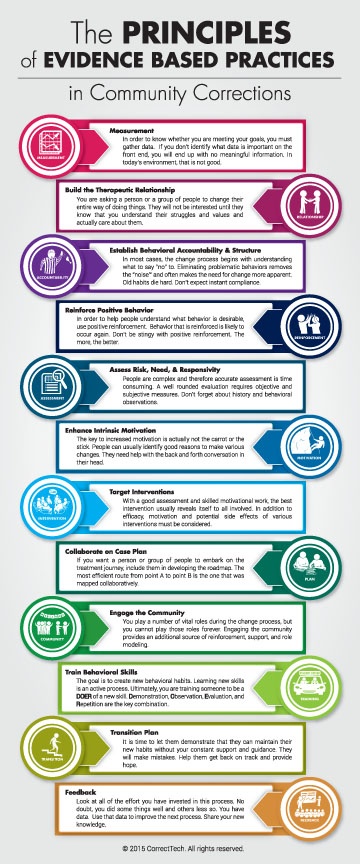- Home
- Software
- Support and Services
- Programs We Serve
- EBP
- Testimonials
- Blog
- About Us
- Resources
In most cases, the change process begins with understanding what to say “no” to. Eliminating problematic behaviors often makes the need for change more apparent. Old habits die hard. Don’t expect instant compliance.
With greater emphasis on offender treatment, some tend to believe that structure and behavioral accountability are at best unnecessary and at worst, punitive.
Structure includes rules, roles, and expectations and by definition limits one’s freedom. Some individuals are able to provide their own structure. Many are not. While it may be related to neuropsychological deficits, one thing is clear: most offenders need structure. They crave structure, but hate it; need it but resent it. For clients who fail to plan, the lack of structure can be a real problem. Such individuals need external structure to color inside the lines. Many offenders perform perfectly with structure.
When EBP experts advocate for adopting a “treatment” mentality rather than a “law enforcement” mentality, they are not espousing that rules and consequences are unimportant. Clearly, there needs to be balance and a treatment emphasis is needed. Still, let’s not forget that our first priority is immediate community safety. This principle, which does not contradict the original principles of effective intervention, has been added for two reasons:
Perhaps most importantly, it is impossible to focus on changing a given behavior if you continue to engage in the behavior. Far from being punitive, providing behavioral accountability is part of the treatment process. Does that mean that electronic monitoring is an evidence-based practice? Is frequent monitoring treatment? Does the structure of a work release program, in the absence of formal treatment lead to long-term behavior change? Monitoring Matters: Failing to provide structure and accountability is not an act of kindness.
Not unlike the therapeutic relationship, structure and behavioral accountability are necessary but not sufficient. Alone, they are unlikely to create change. Still, offender treatment programs that do not include behavioral consequences are equally unlikely to create change. Behavioral accountability should be swift, certain and consistent. The severity of the punishment is largely irrelevant while the key is that there always is a consequence and that it always occurs as close in time to the behavior as possible. The concept of accountability and treatment do not work against each other, they work better together.
Common practice suggests that the element of surprise in the punishment is key to its effectiveness. However, when behavioral consequences are written down and provided ahead of time to an offender, it increases personal responsibility. Unknown consequences result in greater risk taking and excuse making. The element of surprise in punishment is not a good practice. You want your clients to own their behavior and decision making right? Give them the information they need to understand the rules of the road and help them own the outcome.
When the client knows what the consequence, whether positive or negative, of a given action will be they “earn” it rather than staff “issuing” it.
We've developed our technology to take the guesswork out of sanctions, random monitors, incident reports, group sessions and trip planning (to name a few) making accountability monitoring a breeze and enabling case managers to make meaningful relationships with their clients. Click on our software icons below to see how we've implemented accountability in our software.

CorrectTech offers integrated software and support services for residential, treatment, reentry, juvenile and probation programs. Our community corrections software was designed by community corrections professionals to guide organizations toward a powerful EBP implementation, relieve them of strenuous paperwork and manual processes, and enable them to focus on what matters - people! To request more information or schedule a demonstration of our software, click here.
CorrectTech, Inc.
info@correcttech.com
Copyright 2018 CorrectTech, Inc. All Rights Reserved.